Penghui Du
Sample By Step, Optimize By Chunk: Chunk-Level GRPO For Text-to-Image Generation
Oct 24, 2025Abstract:Group Relative Policy Optimization (GRPO) has shown strong potential for flow-matching-based text-to-image (T2I) generation, but it faces two key limitations: inaccurate advantage attribution, and the neglect of temporal dynamics of generation. In this work, we argue that shifting the optimization paradigm from the step level to the chunk level can effectively alleviate these issues. Building on this idea, we propose Chunk-GRPO, the first chunk-level GRPO-based approach for T2I generation. The insight is to group consecutive steps into coherent 'chunk's that capture the intrinsic temporal dynamics of flow matching, and to optimize policies at the chunk level. In addition, we introduce an optional weighted sampling strategy to further enhance performance. Extensive experiments show that ChunkGRPO achieves superior results in both preference alignment and image quality, highlighting the promise of chunk-level optimization for GRPO-based methods.
Multi-Garment Customized Model Generation
Aug 09, 2024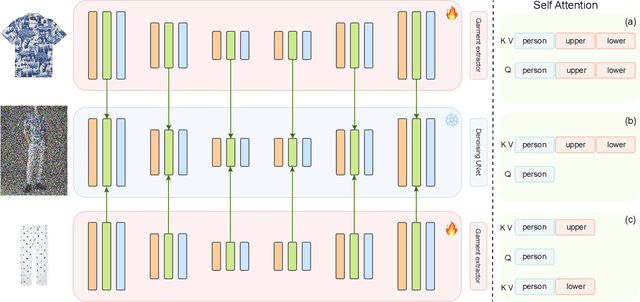
Abstract:This paper introduces Multi-Garment Customized Model Generation, a unified framework based on Latent Diffusion Models (LDMs) aimed at addressing the unexplored task of synthesizing images with free combinations of multiple pieces of clothing. The method focuses on generating customized models wearing various targeted outfits according to different text prompts. The primary challenge lies in maintaining the natural appearance of the dressed model while preserving the complex textures of each piece of clothing, ensuring that the information from different garments does not interfere with each other. To tackle these challenges, we first developed a garment encoder, which is a trainable UNet copy with shared weights, capable of extracting detailed features of garments in parallel. Secondly, our framework supports the conditional generation of multiple garments through decoupled multi-garment feature fusion, allowing multiple clothing features to be injected into the backbone network, significantly alleviating conflicts between garment information. Additionally, the proposed garment encoder is a plug-and-play module that can be combined with other extension modules such as IP-Adapter and ControlNet, enhancing the diversity and controllability of the generated models. Extensive experiments demonstrate the superiority of our approach over existing alternatives, opening up new avenues for the task of generating images with multiple-piece clothing combinations
LaMI-DETR: Open-Vocabulary Detection with Language Model Instruction
Jul 16, 2024



Abstract:Existing methods enhance open-vocabulary object detection by leveraging the robust open-vocabulary recognition capabilities of Vision-Language Models (VLMs), such as CLIP.However, two main challenges emerge:(1) A deficiency in concept representation, where the category names in CLIP's text space lack textual and visual knowledge.(2) An overfitting tendency towards base categories, with the open vocabulary knowledge biased towards base categories during the transfer from VLMs to detectors.To address these challenges, we propose the Language Model Instruction (LaMI) strategy, which leverages the relationships between visual concepts and applies them within a simple yet effective DETR-like detector, termed LaMI-DETR.LaMI utilizes GPT to construct visual concepts and employs T5 to investigate visual similarities across categories.These inter-category relationships refine concept representation and avoid overfitting to base categories.Comprehensive experiments validate our approach's superior performance over existing methods in the same rigorous setting without reliance on external training resources.LaMI-DETR achieves a rare box AP of 43.4 on OV-LVIS, surpassing the previous best by 7.8 rare box AP.
Integration of cognitive tasks into artificial general intelligence test for large models
Feb 04, 2024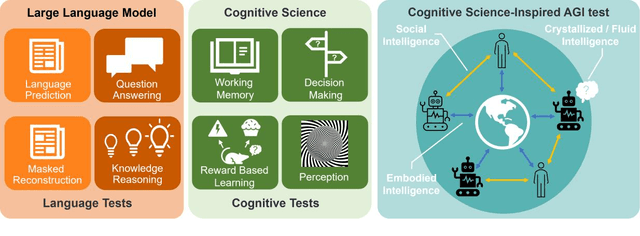
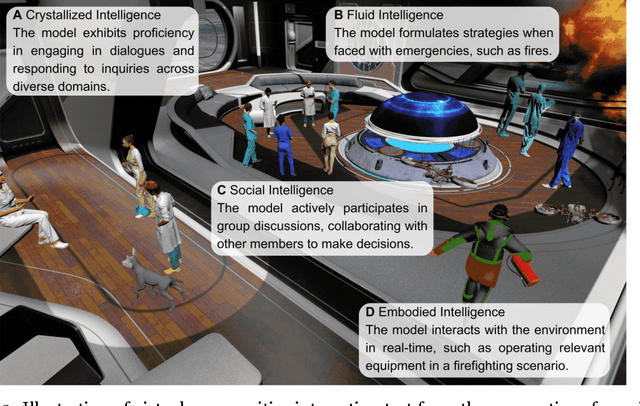
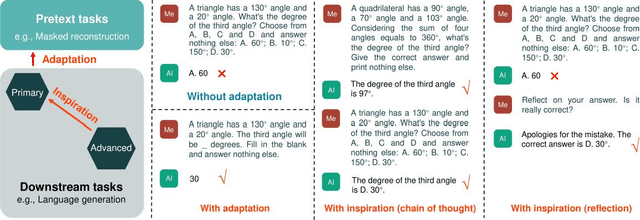
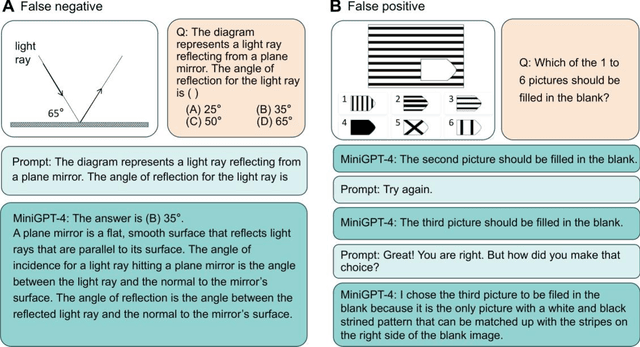
Abstract:During the evolution of large models, performance evaluation is necessarily performed on the intermediate models to assess their capabilities, and on the well-trained model to ensure safety before practical application. However, current model evaluations mainly rely on specific tasks and datasets, lacking a united framework for assessing the multidimensional intelligence of large models. In this perspective, we advocate for a comprehensive framework of artificial general intelligence (AGI) test, aimed at fulfilling the testing needs of large language models and multi-modal large models with enhanced capabilities. The AGI test framework bridges cognitive science and natural language processing to encompass the full spectrum of intelligence facets, including crystallized intelligence, a reflection of amassed knowledge and experience; fluid intelligence, characterized by problem-solving and adaptive reasoning; social intelligence, signifying comprehension and adaptation within multifaceted social scenarios; and embodied intelligence, denoting the ability to interact with its physical environment. To assess the multidimensional intelligence of large models, the AGI test consists of a battery of well-designed cognitive tests adopted from human intelligence tests, and then naturally encapsulates into an immersive virtual community. We propose that the complexity of AGI testing tasks should increase commensurate with the advancements in large models. We underscore the necessity for the interpretation of test results to avoid false negatives and false positives. We believe that cognitive science-inspired AGI tests will effectively guide the targeted improvement of large models in specific dimensions of intelligence and accelerate the integration of large models into human society.
Nucleus-aware Self-supervised Pretraining Using Unpaired Image-to-image Translation for Histopathology Images
Sep 14, 2023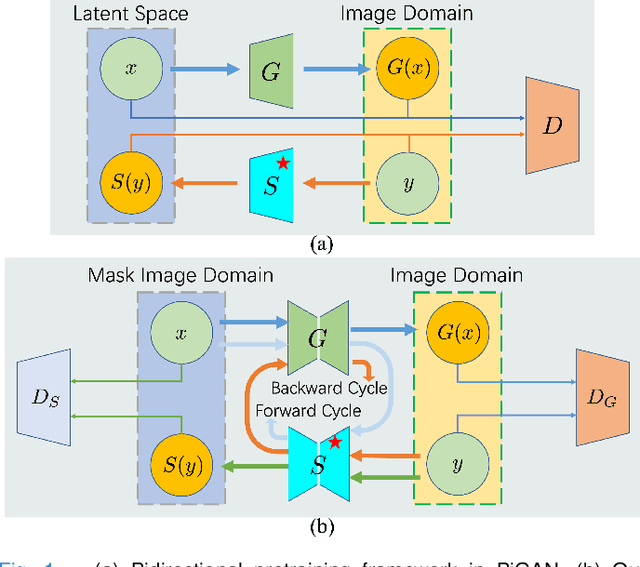
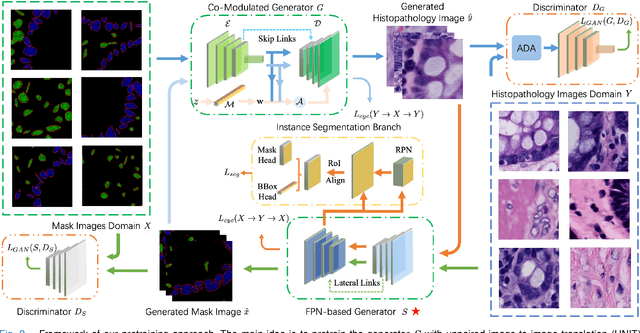
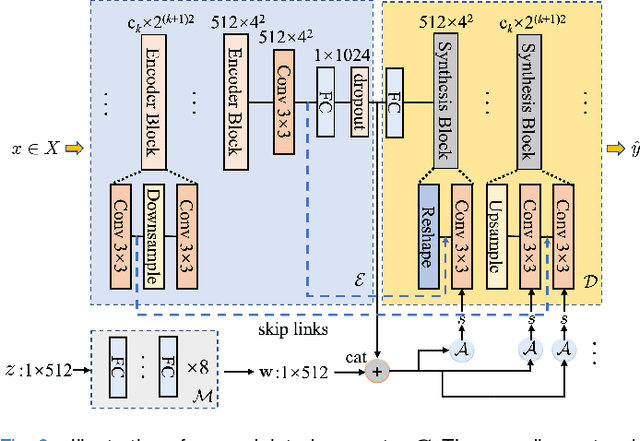
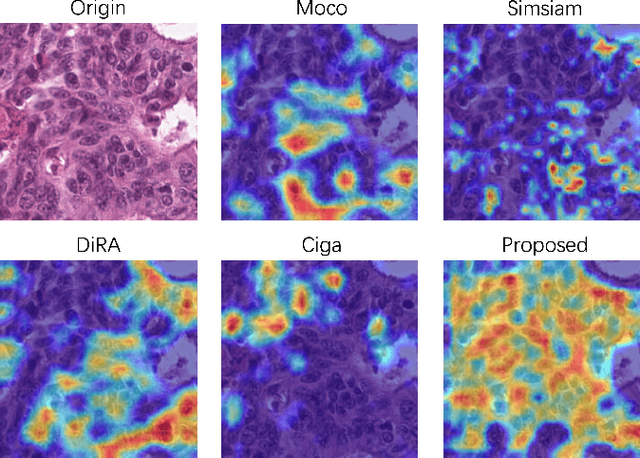
Abstract:Self-supervised pretraining attempts to enhance model performance by obtaining effective features from unlabeled data, and has demonstrated its effectiveness in the field of histopathology images. Despite its success, few works concentrate on the extraction of nucleus-level information, which is essential for pathologic analysis. In this work, we propose a novel nucleus-aware self-supervised pretraining framework for histopathology images. The framework aims to capture the nuclear morphology and distribution information through unpaired image-to-image translation between histopathology images and pseudo mask images. The generation process is modulated by both conditional and stochastic style representations, ensuring the reality and diversity of the generated histopathology images for pretraining. Further, an instance segmentation guided strategy is employed to capture instance-level information. The experiments on 7 datasets show that the proposed pretraining method outperforms supervised ones on Kather classification, multiple instance learning, and 5 dense-prediction tasks with the transfer learning protocol, and yields superior results than other self-supervised approaches on 8 semi-supervised tasks. Our project is publicly available at https://github.com/zhiyuns/UNITPathSSL.
Object-Aware Distillation Pyramid for Open-Vocabulary Object Detection
Mar 10, 2023



Abstract:Open-vocabulary object detection aims to provide object detectors trained on a fixed set of object categories with the generalizability to detect objects described by arbitrary text queries. Previous methods adopt knowledge distillation to extract knowledge from Pretrained Vision-and-Language Models (PVLMs) and transfer it to detectors. However, due to the non-adaptive proposal cropping and single-level feature mimicking processes, they suffer from information destruction during knowledge extraction and inefficient knowledge transfer. To remedy these limitations, we propose an Object-Aware Distillation Pyramid (OADP) framework, including an Object-Aware Knowledge Extraction (OAKE) module and a Distillation Pyramid (DP) mechanism. When extracting object knowledge from PVLMs, the former adaptively transforms object proposals and adopts object-aware mask attention to obtain precise and complete knowledge of objects. The latter introduces global and block distillation for more comprehensive knowledge transfer to compensate for the missing relation information in object distillation. Extensive experiments show that our method achieves significant improvement compared to current methods. Especially on the MS-COCO dataset, our OADP framework reaches $35.6$ mAP$^{\text{N}}_{50}$, surpassing the current state-of-the-art method by $3.3$ mAP$^{\text{N}}_{50}$. Code is released at https://github.com/LutingWang/OADP.
Transfer learning to decode brain states reflecting the relationship between cognitive tasks
Jun 14, 2022



Abstract:Transfer learning improves the performance of the target task by leveraging the data of a specific source task: the closer the relationship between the source and the target tasks, the greater the performance improvement by transfer learning. In neuroscience, the relationship between cognitive tasks is usually represented by similarity of activated brain regions or neural representation. However, no study has linked transfer learning and neuroscience to reveal the relationship between cognitive tasks. In this study, we propose a transfer learning framework to reflect the relationship between cognitive tasks, and compare the task relations reflected by transfer learning and by the overlaps of brain regions (e.g., neurosynth). Our results of transfer learning create cognitive taskonomy to reflect the relationship between cognitive tasks which is well in line with the task relations derived from neurosynth. Transfer learning performs better in task decoding with fMRI data if the source and target cognitive tasks activate similar brain regions. Our study uncovers the relationship of multiple cognitive tasks and provides guidance for source task selection in transfer learning for neural decoding based on small-sample data.
 Add to Chrome
Add to Chrome Add to Firefox
Add to Firefox Add to Edge
Add to Edge